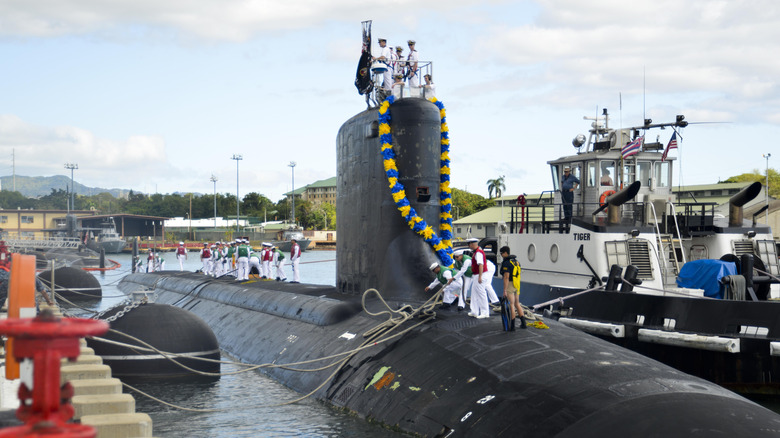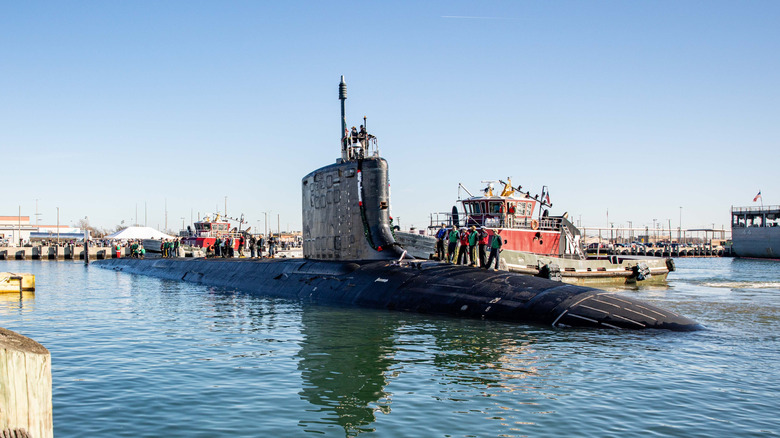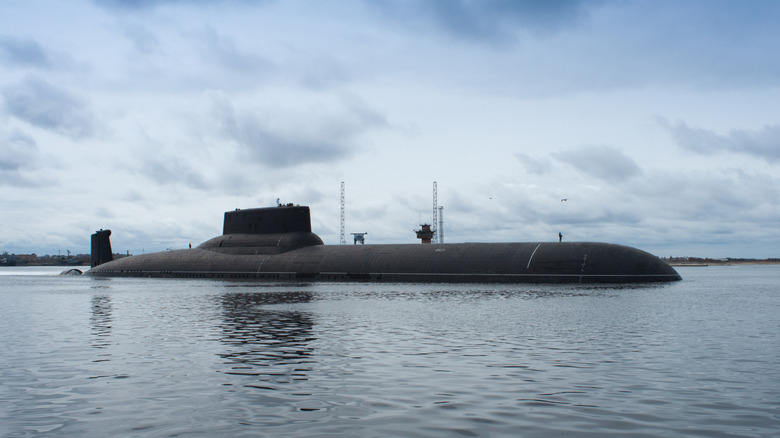This Advanced Nuclear Submarine Is Set To Join The US Navy's Fleet Soon After Successful Testing
When it comes to nuclear submarines, the U.S. is the undisputed global leader, operating the majority of nuclear submarines in existence today. Besides the United States (which has nearly 70 nuclear submarines), the only other militaries that possess a fleet of nuclear submarines are Russia (31), China (12), the U.K. (10), France (9), and India (2). The scale of America's naval dominance is evident from the fact that its nuclear submarine fleet alone outnumbers the combined fleets of all other nations that operate these vessels. Further bolstering the United States' submarine capabilities is the upcoming commissioning of the USS Massachusetts (SSN 798), a new attack submarine that recently completed its initial sea trials. Although the construction of the USS Massachusetts is complete, it will be some time before this sub is formally inducted into the U.S. Navy; however, it could happen as early as 2026.
Once inducted, the USS Massachusetts will join the expanding fleet of the U.S. Navy's Virginia-class attack submarines. For the uninitiated, the Virginia-class is the U.S.'s most modern attack submarine type, featuring several upgrades to the older Los Angeles-class (SSN 688) and Seawolf-class submarines. These attack submarines are also built for a different purpose than the other two manned submarines currently operated by the U.S Navy: Ballistic Missile Submarines (SSBN), and Guided Missile Submarines (SSGN). The technological advancements incorporated into the Virginia-class attack submarines — and, by extension, into the USS Massachusetts — include quieter propulsion, improved underwater acoustics, modular construction, and well-integrated combat systems.
USS Massachusetts (SSN 798) and other Block IV Virginia-class submarines
The USS Massachusetts is part of the Block IV batch of Virginia-class submarines, which includes as many as 10 submarines, starting with the USS Vermont (SSN 792) and going up to the USS Utah (SSN 801). All subs in this batch are designed to handle various types of missions, ranging from hunting enemy submarines and gathering intelligence to serving as a support vessel during special operations. The companies contracted to build the USS Massachusetts are Huntington Ingalls Industries (HII) and General Dynamics Electric Boat. Several Block IV submarines have been commissioned as of 2025, with some others, including the USS Massachusetts, currently undergoing sea trials. Some others, like the USS Idaho (SSN 799), the USS Arkansas (SSN 800), and the USS Utah (SSN 801), are in various stages of construction.
All ten Block IV batch Virginia-class submarines focus on reliability and reduced downtime. Unlike older Virginia-class submarines that need four major maintenance overhauls, Block IV boats need only three, giving each one an extra deployment over its 33-year service life. In terms of changes from the older Block III submarines, Block IV subs get two large Virginia Payload Tubes, all of which can fire six Tomahawk cruise missiles. Block IV subs also retain the redesigned Large Aperture Bow sonar from Block III models, enabling the sub to "see" under the sea with enhanced clarity. The USS Massachusetts is identical in size to other members of the Block IV batch of Virginia-class submarines. It is 377 feet in length and has a beam of 34 feet. Weighing over 7,800 tons (10,200 tons when submerged), the USS Massachusetts can travel at speeds of up to 25 knots. It can accommodate a crew of 145, which includes 17 officers.
What's next after Block IV Virginia-class submarines?
While the Virginia-class submarines are technically the newest category of attack submarines in the U.S. Navy, the first of these submarines has been around since 2004, making them over 20 years old as of 2025. To keep these underwater giants up to date, the U.S. Navy ensured that they were regularly updated as part of multiple "block" upgrades. The first four Virginia-class submarines were part of Block I, while the subsequent six belonged to Block II, featuring incremental upgrades. Major changes came with the eight Block III variants starting in 2014 with the USS North Dakota (SSN 784), and ending in 2020 with the USS Delaware (SSN 791). These Block III variants featured a redesigned bow with a new sonar array, while also adding two VPTs (Virginia Payload Tubes) tubes that could hold up to six missiles each.
The current generation of Virginia-class submarines is all part of the Block IV series, with the USS Massachusetts being one of the last of its category. Upcoming Block IV Virginia-class submarines include the USS Idaho (SSN 799), USS Arkansas (SSN 800), and the USS Utah (SSN 801). Even after the last of the planned Block IV submarines (USS Utah) is delivered, the Virginia-class submarines will continue to evolve by moving on to the next-generation models under the Block V and Block VI programs. Needless to say, we can expect the Virginia-class submarines to serve the interests of the U.S. Navy, as well as its allies, for the foreseeable future.


